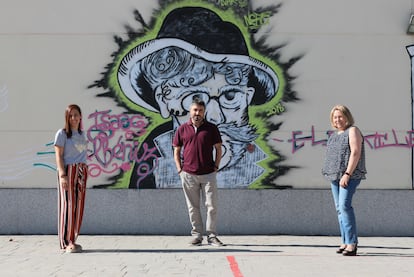Defenders of bilingual education in Spain: ‘It’s a mistake to think that students will speak English like they do Spanish’
Language experts and teachers in primary and secondary schools discuss the pros and cons of a system that many feel has failed to provide the desired skills


In recent years, an educational trend has gained new traction, one that holds that a pure British accent – the Queen’s English – no longer has to be the one that prevails when teaching, learning or using English to communicate. This trend, known as ELF (English as a lingua franca), favors a more neutral pronunciation where the goal is to get the message across.
“The important thing now is being able to communicate; the purity of the accent is a thing of the past,” holds María Luisa Pérez, a professor of English studies at Jaén University and a leading researcher on this issue.
This line of thinking bears a relationship to the debate on whether the bilingual Spanish-English education model used in some public schools in Spain is really up to par, considering that some regions – which have devolved powers over education – ask teachers for a B2 level, indicating fluency but not proficiency as defined by the Common European Framework of Reference for Languages (CEFRL). Other regions require teachers to prove a C1 level, for proficient users of the language.
In recent years, nearly 90 centers have dropped out of the bilingual education system, viewing it as ineffective. But Pérez, just like other experts, warns that many people simply have the wrong idea of what a bilingual model really does. “It’s a mistake to think that children will end up speaking English just like they speak Spanish; the goal is for them to achieve a functional level that will let them communicate and work in the future,” she explains.
Spain’s first English-Spanish bilingual program for public schools was introduced in 1996 as a joint initiative of the Spanish Education Ministry and the British Council. The goal was for students to become “fluent” in English, considered “decisive to favor employment prospects and professional ambitions.” Starting in the year 2000, regional governments began to launch their bilingual programs, and the number of enrolled students has grown 498% in a decade.
At no point was it ever claimed that students would end up speaking perfect English, although that continues to be the hope of many families who sign up their children for these programs. So says David Marsh, who back in the 1990s (before the bilingual model was introduced) coordinated a team of psychologists, educators and scientists to analyze why, after eight years of studies at schools in various European countries, graduating students were barely able to put together a single sentence in English.
False expectations
Marsh and his team detected that the major problem was the methodology used at centers, based on memorizing and repeating concepts, with critical thinking relegated to a secondary role. Their solution was a system called CLIL (Content and Language Integrated Learning), which was included in the action plan to promote linguistic diversity launched by the European Commission between 2004 and 2006, and which lies at the heart of today’s bilingual model.
This system defended learning a new language through the study of other subject matter such as maths, geography and history. But there was a limit: the student would never actually speak the second language as well as their native one. “The word bilingual is dangerous and it creates false expectations,” says Marsh. “Families think that if they take their children to a bilingual school, they will learn another language in a short space of time, but the real goal is for Europeans to be able to communicate at a basic level.”
Administrators at the Isaac Albéniz secondary school in Leganés (Madrid) defend the bilingual model and report being pleased with the results. “Getting students to speak perfect English is impossible, we the teachers are not native-like, but we know enough to teach secondary school kids,” says Inmaculada Alonso, head of studies at the school and herself an English teacher. Alonso was a member of a panel that assessed teachers’ ability to be part of the bilingual program in the Madrid region, which requires a C1 level. “In the oral test, which is around 15 minutes, we made them talk about their life, their favorite movies...we didn’t let just anyone pass,” she says.
Her colleague Óscar García, another school administrator, is convinced that accent plays a secondary role. “Some of them [students] have better pronunciation than others, but what’s really improved is their understanding, the way they follow the classes... we’re on the right track.” he says.
However, there are many Spanish teachers who believe that under the current system, students are neither learning English properly nor grasping the content that’s being taught in that language – in primary school, natural and social sciences as well as arts and crafts; in secondary school, 40% of courses including geography, history, physics, chemistry and biology.
But there are studies showing that performance in English has improved, while remaining stable in other subjects taught in that language. In 2018, the universities of Jaén and Córdoba published the Mon-CLIL report after working with a sample of 2,245 students at 43 public centers, three private ones and eight concertados (semi-private) in the regions of Andalusia, Extremadura and the Canary Islands. This report showed that children in bilingual programs scored 1.23 points higher in English than their peers in monolingual programs at the primary level, and 2.4 points higher at the secondary level. But they also performed 0.46 points better on Spanish at the primary level, and one point higher at the secondary level. As for other content taught in English, kids in their fourth year of secondary education scored 0.50 points higher than students in non-bilingual programs.
The same report also underscored the problems with training teachers in bilingual programs, including a lack of familiarity with the concept of CLIL, which theoretically lies at the heart of the new methodology. Another weak point was the teachers’ low skills when the time came to communicate effectively in English with their students in class.
“Every man for himself”
Pedro, a 36-year-old interim teacher at a bilingual secondary school in Torrejón de Ardoz (Madrid), has never heard of CLIL. “Nobody has told me how I should teach my class; my understanding is that it falls within our academic freedom. The only thing they made quite clear is that classes had to be taught 100% in English and that tests have to be administered in English as well.” In his view, the situation could well be summarized as “every man for himself.” He obtained the C1 certificate during a year he spent at Oxford and teaching in English is not a problem for him, but he has received no specific training in methodology. No regional government requires this in order to teach in a bilingual program.
Enrique Lafuente, who teaches a master’s degree in teacher training at Zaragoza University and has a degree in English studies, believes that the biggest problem lies in the fact that bilingual programs were launched without previously providing sufficient, extensive teacher training. “It’s not just about translating a textbook into English and teaching the class just like you would in Spanish,” he notes. “The CLIL involves a specific methodological change. Before starting on a new subject, you ask students what they already know and make them share it out loud with their peers. This creates a preliminary reflection as well as stimulating motivation.”
The teachers should have basic knowledge of how a new language is learned, and help students produce texts as well as hold conversations in that language. “Teachers should provide the scaffolding, text structures that can be imitated in order to produce work of a certain quality... the science teacher must be aware of the student’s linguistic needs.”
The program created by the Education Ministry and the British Council, with 147 participating public schools in 10 regions of Spain, theoretically includes something called a linguistic advisor, who serves as a coordinator of sorts and is required to have experience in the Anglo education system, preferably with field experience in the United Kingdom. This individual is in charge of conveying educational strategies to the teaching staff, and planning an integrated curriculum combining the Spanish coursework with elements of the British system. But this role does not in fact exist in Spain’s public bilingual schools – instead, there is a coordinator who is typically the school teacher with the strongest English skills.
English version by Susana Urra.
Tu suscripción se está usando en otro dispositivo
¿Quieres añadir otro usuario a tu suscripción?
Si continúas leyendo en este dispositivo, no se podrá leer en el otro.
FlechaTu suscripción se está usando en otro dispositivo y solo puedes acceder a EL PAÍS desde un dispositivo a la vez.
Si quieres compartir tu cuenta, cambia tu suscripción a la modalidad Premium, así podrás añadir otro usuario. Cada uno accederá con su propia cuenta de email, lo que os permitirá personalizar vuestra experiencia en EL PAÍS.
¿Tienes una suscripción de empresa? Accede aquí para contratar más cuentas.
En el caso de no saber quién está usando tu cuenta, te recomendamos cambiar tu contraseña aquí.
Si decides continuar compartiendo tu cuenta, este mensaje se mostrará en tu dispositivo y en el de la otra persona que está usando tu cuenta de forma indefinida, afectando a tu experiencia de lectura. Puedes consultar aquí los términos y condiciones de la suscripción digital.
More information
Últimas noticias
Welcome to the post-religion era: The idea of Christianity as the absolute truth has become obsolete
‘I thought you would like it’: The risky sexual practice popularized by TV shows and TikTok
The digitalization of tourism: ‘They promise experiences and gave us the worst possible one’
Mexican peso defies uncertainty with forecasts of a new period of stability in 2026
Most viewed
- Sinaloa Cartel war is taking its toll on Los Chapitos
- Oona Chaplin: ‘I told James Cameron that I was living in a treehouse and starting a permaculture project with a friend’
- Reinhard Genzel, Nobel laureate in physics: ‘One-minute videos will never give you the truth’
- Why the price of coffee has skyrocketed: from Brazilian plantations to specialty coffee houses
- Silver prices are going crazy: This is what’s fueling the rally









































